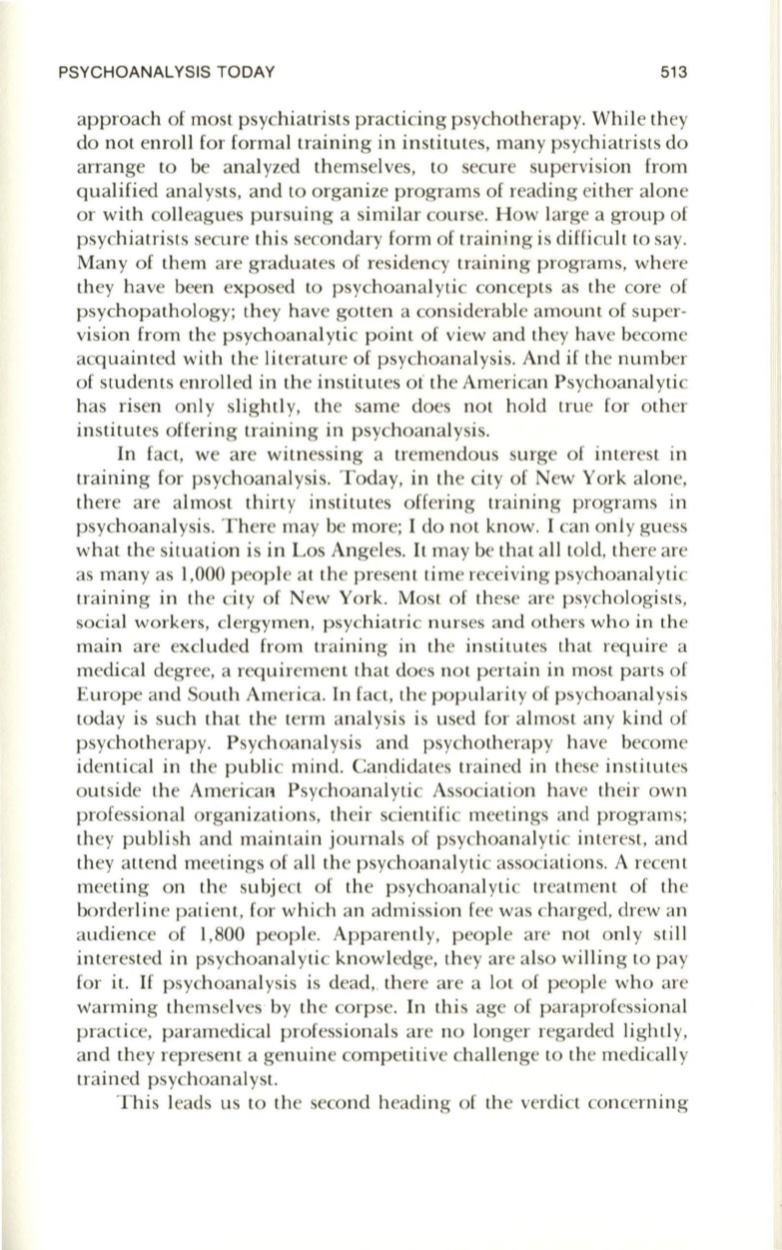
PSYCHOANALYSIS TODAY
513
approach of most psychia trists practicing psychotherap y. Whil e they
do not enroll for formal training in institutes, man y psychia trists do
arrange to be analyzed themselves, to secure supervi sion from
qualified analysts, and to organize programs of reading either alone
or with coll eagues pursuing a similar course. How large a group of
psychiatrists secure thi s secondary form of training is diffi cult to say.
Many of them are gradua tes of residen cy training programs, where
they h ave been exposed to psychoanalytic concepts as the core of
psychopa thology; they have gotten a con siderable amount of super–
vision from the psychoanalytic point of vi ew and they have become
acquainted with the litera ture of psychoanalysis. And if the number
of students enroll ed in the institutes ot the American Psychoanalytic
has risen onl y slightl y, the same does no t ho ld true for other
institutes offering training in psychoanalysis.
In fact, we are witnessing a tremendous surge of interes t in
training for psych oanalysis. Today, in the city of New York alone,
there are almost thirty institutes offering training programs in
psychoanalysis. There may be more; I do no t know. I can onl y guess
what the situa tion is in Los Angeles. It may be tha t all told, there are
as man y as 1,000 p eopl"e a t the present time receiving psychoanalyti c
training in the city of New York. Most of these are psychologists,
social workers, cl ergymen , psychiatric nurses and o thers who in the
main are excluded from training in the institutes that require a
medical degree, a requirement tha t does no t pertain in most p arts of
Europe and South America. In fact, the popularity of psychoanalysis
today is such tha t the term analysis is used for almos t any kind of
psychotherapy. Psychoanalysis and psychotherap y have become
identi cal in the public mind. Candida tes trained in these institutes
outside the American Psychoanal yti c Associa ti on have their own
professional organi zati ons, their scientific meetings and programs;
they publish and maintain journals of p sychoanalyti c interest, and
they attend meetings of all the psychoanalytic associa tions. A recent
meeting on the subj ect of the p sychoanalyti c trea tment of the
borderline patient, for whi ch an admi ssion fee was charged, drew an
audi ence of 1,800 people. Apparentl y, p eople are not onl y still
interested in psychoan alyti c knowl edge, they are also willing to pay
for it.
If
psychoan alysis is dead, there are a lot of people who are
warming themselves by the corpse. In thi s age of pa raprofessional
practi ce, paramedi cal professionals are no longer rega rded li ghtl y,
and they represent a genuine competiti ve chall enge to the medicall y
trained psychoan alyst.
This leads u s to the second h eading of the verdict concerning


